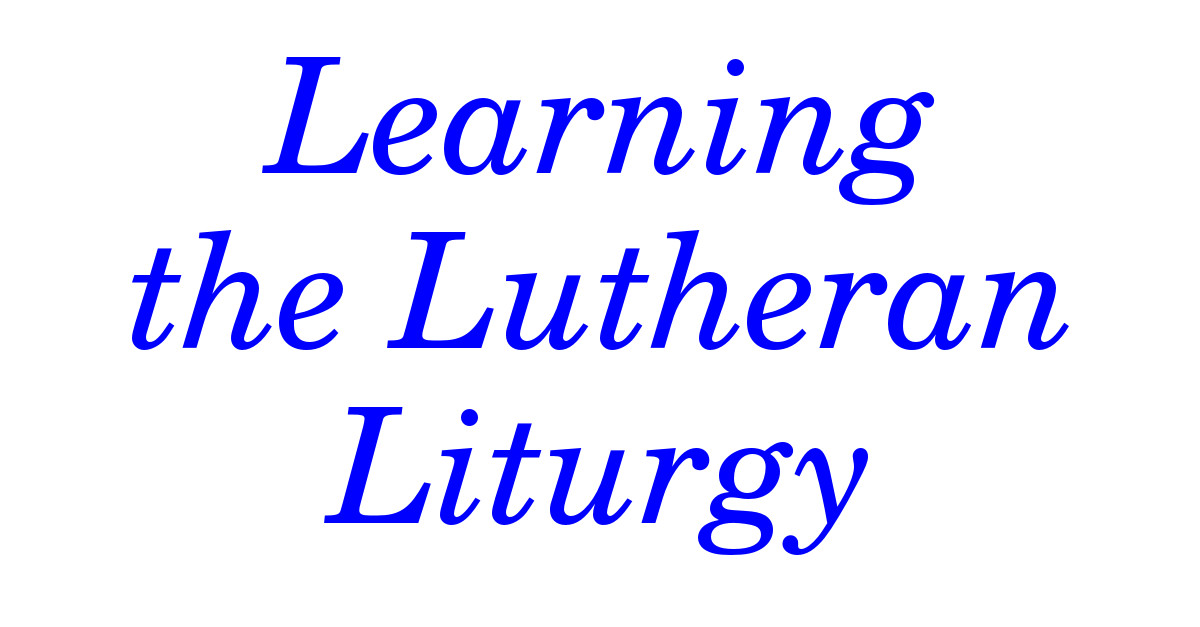By Jonathan Conner
May 2016
The Introit
With our sins forgiven by Christ through the Church’s called and ordained servant who speaks “in the stead and by the command” of Christ, we joyfully enter what is termed “The Service of the Word” with the Introit. The Service of the Word centers on the read Word (through the Introit and readings) and the proclaimed Word (through the sermon).
“Introit” means “entrance” or “beginning.” Traditionally, the pastor entered the sanctuary (the space within the altar rail) while the introit was sung. The introit, which is a compilation of Psalm verses, marked the beginning of The Service of the Word. It is designed to announce the theme of the particular Sunday or season. Take, for example, the introit for Transfiguration Sunday. It leads off with these words from Psalm 99:9:
Exalt the LORD our God, and worship at his holy mountain;
for the LORD our God is holy!
These words lead off and conclude the introit and masterfully use the Old Testament text, which Jesus declared bore witness about him, to point us to Christ’s transfiguration on the mountain.
Every introit also contains an ascription to our Triune God: “Glory be to the Father, and to the Son, and to the Holy Spirit.” This “Gloria” distinguishes the use of the Psalms in the New Testament Church from its use in the Synagogue. According to Jesus’s word, the Old Testament Scriptures are fulfilled in and by Him. We acknowledge this by giving glory to our Triune God in the Gloria.
The Kyrie (Lord, Have Mercy)
With the theme of the day set and the fulfillment of the Scriptures proclaimed, we are ready to move closer to God. We do that by imploring Him to be merciful and hear our prayer. This prayer for mercy echoes in the Kyrie. “Kyrie” is a shorted title from the fuller “Kyrie Eleison,” which means “Lord, have mercy.”
Unlike the Confession which specifically implored God for forgiveness, the Kyrie is a prayer for grace and help in time of need. The Kyrie recognizes our mortality and the brokenness of our reality and our urgent need for God’s mercy. In numerous places and contexts these words echo from people’s lips in Scripture. Blind men beg for mercy in Matthew 9, lepers implore Jesus for mercy in Luke 17, a Canaanite woman asks for mercy in Matthew 15, along with many others (see Mark 10:47 and Luke 18:35–43).
The Gloria in Excelsis
Immediately following the Kyrie we join in the Gloria in Excelsis, which means “Glory to God in the Highest.” Scripture teems with glorias to God. Perhaps the best known first echoed on the hills outside Bethlehem as the angel choirs, in strains of holy rapture and joy, announced Christ’s birth: “Glory to God in the highest, and on earth peace among those with whom he is pleased!”
The Gloria, immediately following the Kyrie, serves as the church’s response to God’s unmerited mercy in sending His Son Jesus to be the world’s Savior. As such, the Gloria acknowledges that God has been merciful in Christ. God has answered our prayer in Jesus. The only appropriate response is an enthusiastic Gloria. From considerations of human need in the Kyrie to contemplations of the Holy Trinity’s majesty, mercy, and power, the Gloria lifts worshipers from human brokenness and need into a thrilling anthem of praise and a joyful chorus of redemption.
The Collect of the Day
Upon singing the Gloria’s final chord, the Church transitions into the Collect of the Day. To mark this transition, the pastor says, “The Lord be with you,” to which the congregation responds, “And also with you.” This greeting is repeated throughout Scripture. One thinks immediately of Gabriel’s greeting to the Virgin Mary, “the Lord is with you!” In addition to echoing the repeated greeting of Scripture, the salutation “The Lord be with you” reminds worshipers of the prophet’s promise of Emmanuel, “God with us,” which is fulfilled in Jesus.
Upon the congregation’s response, the entire worship assembly joins their voices in prayer. The Collect of the Day is drawn from an ancient collection of prayers that the Church has written over the generations. Many of our collects are over 1,000 years old (some over 1,500). What a treasure the Church has preserved! Worshippers are able to pray the prayers of the generations that have gone before us in the faith.
Some of the collects have been designed to reflect the thought or mood of the Church season while others were written specifically to prepare worshipers to receive the Divine grace offered in the Scripture readings for the day. Although brief in length, the collects follow a pattern with five parts:
- an invocation;
- a basis for the petition;
- the petition itself;
- the purpose or benefit desired from God; and,
- the conclusion, which is a doxology.
Take the Collect of the Day from the third Sunday in Lent, for example:
O God (the invocation), whose glory it is always to have mercy (the basis for the petition), be gracious to all who have gone astray from Your ways and bring them again with penitent hearts and steadfast faith (the petition) to embrace and hold fast the unchangeable truth of Your Word (the benefit desired); through Jesus Christ, Your Son, our Lord, who lives and reigns with You and the Holy Spirit, one God, now and forever (the doxology conclusion). Amen.
Notice how the prayer invokes God’s name and then begins with a confession of faith in the God whose glory it is to have mercy. This is a strong confession of faith in the God to whom the prayer is addressed. Upon acknowledging God’s merciful nature, the prayer continues by asking God to act in accord with His nature by being gracious to erring and straying souls so as to produce penitent hearts and steadfast faith.
Once penitent hearts and steadfast faith have been produced, the prayer asks God to move souls to cling to the unchangeable truth of His Word. With the confession, request, and benefit spoken, the prayer concludes with a Trinitarian doxology.
Interestingly, many of our hymns follow a similar pattern. Often the first verses call upon God and detail His saving acts detailed in Scripture. Then the final verse(s) sound a prayer for God to act in our lives so that we may better praise and glorify Him. And, as with the Collect, many of our hymns conclude with a doxology to our Triune God.
Even more, our worship services mirror this pattern. Throughout the service we have called upon God’s Name (the Invocation), we have confessed faith in Him and acknowledged His saving acts (The Creed), and we boldly approach Him in prayer in the prayers of the Church. Then we conclude the service with the Trinitarian blessing.
We have been blessed with a rich tradition of prayers. The Church’s prayer collection is a treasure to celebrate and a model to imitate. In the next article, we celebrate the Scriptures, which continue to sound in Christ’s Church.
Pastor Jonathan Conner of Zion Lutheran Church in Manning, Iowa, is a former board member for the Hausvater Project.





